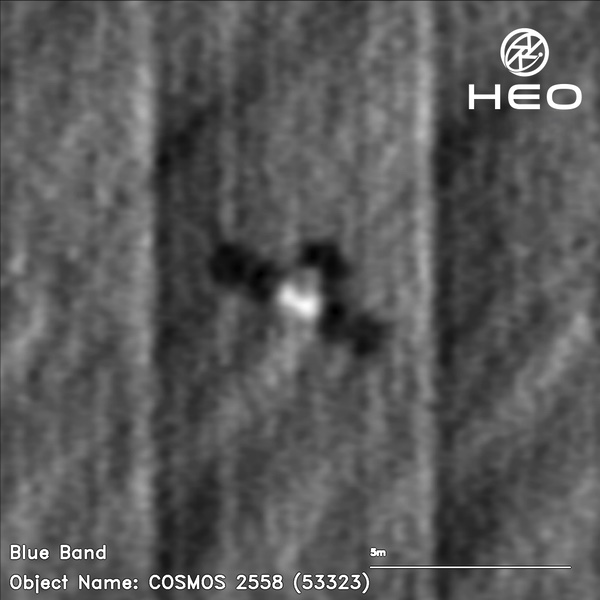Project Nivelir: Russia’s inspection satellites (part 1)by Bart Hendrickx
|
| The first mission to which the Russians themselves applied the term “inspection satellite” took place in 2017. |
The Russian missions can be identified as being part of a project called Nivelir (“dumpy level”), which was initiated in 2011 and appears to have multiple goals. Although much of the project remains wrapped in secrecy, a significant amount of information on it has become available over the years through open-source intelligence. This article attempts to sum up all that can be learned about the project’s organizational background, the design of the satellites and their optical payloads, as well as the ground support infrastructure.[1] It has become clear in recent years that, besides Nivelir, there are a few other projects involving inspection satellites, but these remain poorly understood.
History of Russian inspection satellites
Over the past 12 years, Russia has launched several satellites that have performed both long-distance and close encounters with other satellites in orbit. The first Russian satellites categorized in the West as “inspection satellites” were three objects launched between December 2013 and March 2015 aboard the Rokot launch vehicle. They rode to space as co-passengers with military and civilian communications satellites called Rodnik and Gonets-M. Despite having been immediately detected by US space tracking assets, the existence of the first two was not officially acknowledged by the Russians until they were registered with the United Nations under the names Kosmos-2491 and 2499. Among the payloads of these two satellites was a non-classified one for radio amateurs. The third satellite was announced shortly after launch as Kosmos-2504. The last two satellites performed rendezvous and proximity operations with the Briz-KM upper stage that had delivered them to orbit. Long after their active missions had ended, Kosmos-2491 and 2499 suffered fragmentation events that spawned a significant amount of space debris.
The first mission to which the Russians themselves applied the term “inspection satellite” took place in 2017. It began in June of that year with the launch of Kosmos-2519 aboard a Soyuz-2.1v rocket, a lightweight version of the Soyuz booster. In its launch announcement, the Ministry of Defense gave the mission objectives as remote sensing of the Earth and photography of other objects in space. Orbit parameters showed that the satellite had been placed into the same plane as Kosmos-2486, a Russian optical reconnaissance satellite of the Persona type launched in 2013.
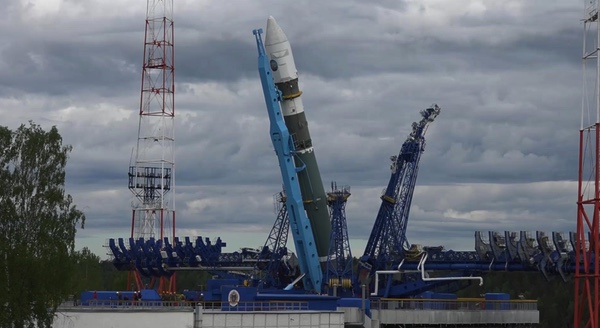 A Soyuz-2.1v rocket being prepared for the launch of Kosmos-2519 in June 2017. Source: Russian Ministry of Defense./div> |
About two months after launch, Kosmos-2519 deployed a subsatellite that was later designated Kosmos-2521. In a press release on the event, the Ministry of Defense announced that the subsatellite was intended “for inspection of another Russian satellite.” In the following weeks, that turned out to be the “parent satellite” itself, with which Kosmos-2521 carried out a series of rendezvous and proximity operations. Observers were in for another surprise in late October 2017, when Kosmos-2521 itself released an object that later got the name Kosmos-2523. This immediately performed a single maneuver that lowered its perigee by about 100 kilometers.
Up next was the launch of another Soyuz-2-1v rocket in July 2019 with a total of four satellites on board (Kosmos-2535, 2536, 2537, and 2538). The latter two were passive radar calibration satellites, but the first two soon started a long series of mutual encounters. The first of those, in August 2019, was the subject of another Ministry of Defense press release, which described one satellite as an “inspection satellite” and the other as a “registering satellite.” They were reportedly on a mission to study the effects of “artificial and natural space factors” on satellites and also to test technology to protect satellites and service them in orbit.
Later in the mission, one of the two satellites generated about two dozen pieces of space debris that ended up in widely scattered orbits, indicating they were the result of some kind of energetic event. The satellites themselves remained operational after these debris-shedding events. During a further series of rendezvous experiments in the final months of 2020 and in March and April 2021, Kosmos-2535 and 2536 were so close together that they could not be individually seen by visual observers. Orbital elements released for the satellites at the time were interpreted by some as indicating they had docked.
In November 2019, Russia launched a mission that was a near carbon copy of the one flown in 2017. It again involved a “parent satellite” (Kosmos-2542), which released a small subsatellite (Kosmos-2543) several days after launch. Tracking data showed that both were in the same orbital plane as the US electro-optical reconnaissance satellite USA 245. They had several distant encounters with the American satellite in late 2019 and early 2020. In July 2020, Kosmos-2543 approached Kosmos-2535 and ejected an object that significantly changed its perigee (by about 100 kilometers) and apogee (by almost 170 kilometers.) While clearly similar to Kosmos-2523, it was not registered by the Russians with the United Nations.
In August 2022 and May 2024, Russia orbited two more satellites (Kosmos-2558 and 2576) that were inserted into the same orbital plane as US reconnaissance satellites (USA 326 and USA 314, respectively.) Unlike its predecessors, Kosmos-2576 was launched by the more powerful Soyuz-2.1b rocket, which also carried a set of small civilian satellites as additional payloads. Russia has not provided any details about Kosmos-2558 and 2576, but all indications are that they are of the same type as Kosmos-2519 and 2542, the only difference with the two earlier missions being that they have so far not released any subsatellites. They have been conducting maneuvers on a regular basis to ensure that their orbits remain synchronized with those of the American satellites, although a new series of orbit corrections by Kosmos-2576 in February are reported to have moved it out of plane with USA 314.
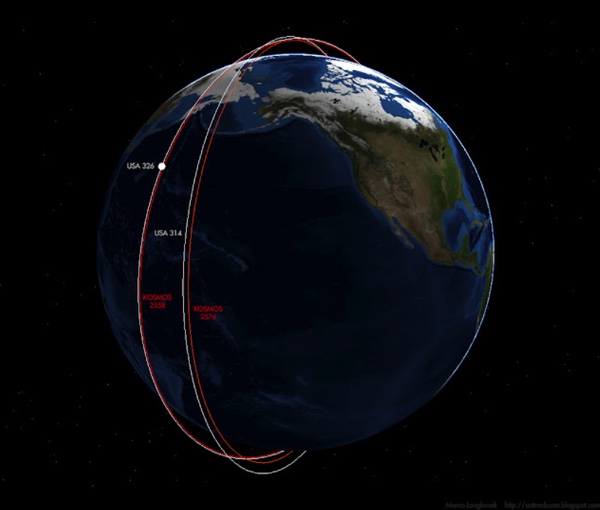 The co-planar orbits of Kosmos-2558/USA 326 and Kosmos-2576/USA 314. Source |
Another satellite on an apparent inspection mission was Kosmos-2562, orbited by a Soyuz-2.1v along with Kosmos-2561 in October 2022. In 2023, it spent several months flying close to the decommissioned Russian remote sensing satellite Resurs-P3 before both re-entered at the end of the year. Small subsatellites with likely inspection missions were launched attached to two electronic intelligence satellites of the Lotos-S type (Kosmos-2565 and 2570) in November 2022 and October 2023. Several weeks after being detached from the parent satellites, they split into two pieces, one of which was presumably an inspection satellite and the other a rendezvous target. While the first mission seems to have failed, the second one saw the inspection satellite (labeled Kosmos-2571) performing rendezvous and proximity operations with the target in December 2024.
Finally, three satellites (Kosmos-2581, 2582, and 2583) launched together this February also have all the hallmarks of being on some type of inspection mission. The Kosmos-2581/2582 pair has been flying in tandem since early March, coming as close as about 50 meters. Kosmos-2583 passed very close to them in early March and is now flying well ahead of them. It released an object, so far unidentified, on March 18.
Identifying the satellites
The missions described above are summarized in the table below. Using a variety of sources, an attempt is made to identify most of the satellites with their Russian military designators. However, it should be stressed that some of these identifications remain uncertain.
| Official name | Presumed military index | Launch date | Status | Comments |
|---|---|---|---|---|
| Kosmos-2491 | 14F153 | 2013 Dec 25 | in orbit (broke up) | solo mission |
| Kosmos-2499 | 14F153 | 2014 May 23 | in orbit (broke up) | RPO* with Briz-KM stage |
| Kosmos-2504 | 14F153 | 2015 Mar 31 | in orbit | RPO with Briz-KM stage |
| Kosmos-2519 Kosmos-2521 Kosmos-2523 | 14F150 14F162 ? | 2017 Jun 23 | re-entered re-entered in orbit | co-planar with Kosmos-2486 ejected from Kosmos-2519 ejected from Kosmos-2521 |
| Kosmos-2535 Kosmos-2536** | 14F157 14F153 | 2019 Jul 10 | in orbit in orbit | RPO with K.-2536 and 2543 RPO with Kosmos-2535 |
| Kosmos-2542 Kosmos-2543 none*** | 14F150 14F162 ? | 2019 Nov 25 | re-entered re-entered in orbit | co-planar with USA 245 ejected from Kosmos-2542 ejected from Kosmos-2543 |
| Kosmos-2558 | 14F150 | 2022 Aug 1 | in orbit | co-planar with USA 326 |
| Kosmos-2562 | 14F164 or 14F172 | 2022 Oct 21 | re-entered | RPO with Resurs-P3 |
| Kosmos-2571 none**** | ? ? | 2023 Oct 27 | in orbit in orbit | ejected from Kosmos-2570 target for Kosmos-2571 |
| Kosmos-2576 | 14F150 | 2024 May 16 | in orbit | co-planar with USA 314 |
| Kosmos-2581 Kosmos-2582 Kosmos-2583 none***** | ? ? ? ? | 2025 Feb 5 | in orbit in orbit in orbit in orbit | RPO with Kosmos-2582 RPO with Kosmos-2581 passed close to K.-2581/2582 ejected from Kosmos-2583 |
*RPO=rendezvous and proximity operations
**catalogued by US Space Command as Kosmos-2538, but later registered by Russia with the UN as Kosmos-2536 (international designator 2019-039D)
***international designator 2019-079E
****international designator 2023-165D
*****international designator 2025-026F
It can be established with a fairly high degree of certainty that Kosmos-2519, 2535, 2542, and 2576 as well as the additional objects deployed in orbit during their missions are part of the Nivelir project. In some documentation, the project is also referred to as 14K167 and 14K245. The first index denotes the so-called “space complex”, a term used by the Russian military for the combination of the satellites, the launch vehicles, and the ground-based infrastructure to launch and control them. The second index stands for the so-called “rocket and space complex”, which is the combination of the rockets, the payloads and the cosmodrome infrastructure needed to launch them.
| It can be established with a fairly high degree of certainty that Kosmos-2519, 2535, 2542, and 2576 as well as the additional objects deployed in orbit during their missions are part of the Nivelir project. |
The satellites flown under this project have their own designators. The parent satellites are called 14F150 and are used for both Earth remote sensing and observations of other satellites. The subsatellites deployed by the first two 14F150 satellites are believed to be called 14F162.[2] Aside from performing an inspection role, they also served as a launch platform for objects that were ejected at high speed and then remained inert. These have been interpreted by the Pentagon as projectiles with a likely counterspace role. Their military index is not known. They did not destroy anything (probably to avoid generating more space debris), but other Russian satellites orbiting in the immediate neighborhood (Kosmos-2519 and Kosmos-2535) do seem to have served as simulated targets. The former commander of the US Space Force, Gen. John Raymond, on several occasions likened the satellites to Russian nesting dolls, with one satellite coming out of another and then in turn deploying a projectile “designed to kill US satellites.”[3]
The Kosmos-2491, 2499, and 2504 satellites launched in 2013–2015 can be traced to the same manufacturer that produced the 14F162 subsatellites. The final of the three can be positively identified as having the index 14F153. It is not clear if they were part of Nivelir. They may also have belonged to an anti-satellite project named Burevestnik or could have been technology demonstrators for both. A star tracker that can be linked to Burevestnik was reported to have been tested in orbit sometime before January 2017, most likely on one or more of these three satellites.
Burevestnik interceptors are probably intended to disable target satellites by detonating small explosive devices in their vicinity and possibly also by spraying them with chemical substances. Operational versions of these satellites are supposed to be launched from the air by small solid-fuel rockets suspended under modified MiG-31BM fighter jets.[4]
The Kosmos-2535/2536 mission was unique because of its debris-shedding events and the possible physical contact between the two satellites. US Space Command identified the source of the debris as Kosmos-2535, but since the two satellites were flying close to one another at the time of these events and the debris ended up in widely scattered orbits, that may not have been easy to determine. In fact, there are some reasons to believe that it emanated from Kosmos-2536. Based on its index (14F153), it looks like it may have been a Burevestnik satellite that tested some type of explosive ASAT payload and that Kosmos-2535 acted as a simulated target, performing the role of what the Ministry of Defense labeled “the registering satellite.” The latter then went on to serve as a phantom target for the ASAT projectile fired by Kosmos-2543. The possible dockings between Kosmos-2535 and 2536 later on in the mission may confirm that one of the other objectives was to test servicing technology, one of the officially announced goals of the mission.
None of the other inspection-type missions listed above can so far be associated with any known projects and they will not be further discussed here.
Organizational background and mission objectives
Online procurement documentation makes it possible to identify the key players in the Nivelir project. It officially got underway on September 30, 2011, with a contract signed between the Ministry of Defense and the Central Scientific Research Institute of Chemistry and Mechanics (TsNIIKhM or CNIIHM) in Moscow, which acts as the prime contractor. During the Soviet days, the institute specialized in the production of various types of solid propellant and explosives. Its only known assignment in the space program was the production of explosive charges for a Soviet co-orbital anti-satellite system that saw several successful tests in orbit. In the first decade of this century, it branched out into other fields, including the development of inspection satellites and new counterspace systems. On the very same day that TsNIIKhM received the Nivelir contract, it was also given a major role in Burevestnik. Two other projects with possible counterspace objectives that were assigned to TsNIIKhM early last decade were Napryazheniye and Numizmat. Their current status is unknown.[5]
The next major step in the Nivelir program came on December 1, 2011, when TsNIIKhM awarded a contract for the project to NPO Lavochkin. Tracing back its origins to the early 1960s, NPO Lavochkin was initially placed in charge of building the Soviet Union’s lunar and interplanetary probes. It later also became involved in a variety of other projects, including Earth-orbiting scientific satellites, missile early warning satellites, and geostationary weather satellites.
NPO Lavochkin’s role in Nivelir was to develop the parent satellites, while TsNIIKhM assumed responsibility for the subsatellites and, presumably, the projectiles fired from the subsatellites. With NPO Lavochkin being responsible for the bigger satellites, its role as a subcontractor may seem somewhat surprising. However, the available procurement documents related to Nivelir leave no doubt that this is indeed the division of labor in the project. Some of them literally state that money allocated for the project by the Ministry of Defense was channeled to NPO Lavochkin by TsNIIKhM, which is exactly what it would be expected to do as prime contractor.
The man in charge of Nivelir at TsNIIKhM is Vladimir I. Verkhoturov, who also heads the institute’s Design Bureau of Applied Mechanics (KBPM), a cover name for its space department. Verkhoturov’s name had publicly appeared mainly in obscure procurement documents and a handful of patents until a brief biography of him appeared recently in a journal of his alma mater in Tomsk, Siberia. After a 40-year career working on communications satellites at ISS Reshetnev and Gazprom, he joined TsNIIKhM in 2008, the same year the KBPM department was set up. While the bio does not mention Nivelir by name, it does acknowledge that Verkhoturov led the development of “technology to monitor space objects in the interests of the country’s information security.”[6] Another TsNIIKhM department engaged in the institute’s space projects is the Nanotechnology Research Center, which was also established in 2008.
 Vladimir Verkhoturov, chief designer of Nivelir. Source |
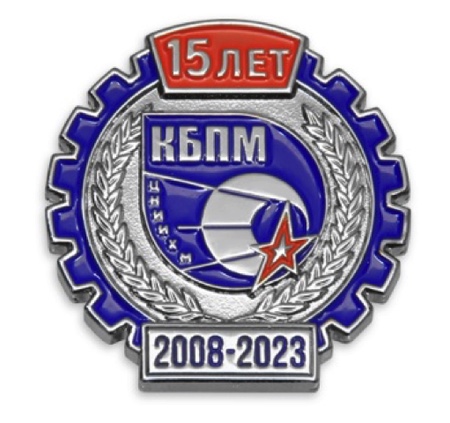 Pin marking the 15th anniversary of KBPM, TsNIIKhM’s secretive space department. Source
|
Although TsNIIKhM is the prime contractor for Nivelir, it is possible that some sort of supervising role in the project is played by MAK Vympel. This is a company that also oversees Russia’s ground-based military space surveillance network, which consists of a variety of telescopes and radars to track objects in orbit. Annual reports published by MAK Vympel from 2010 until 2014 mentioned its involvement in the creation of a space-based space surveillance system, without giving any further details.[7] One further clue comes from an article published in 2015 by NII Televideniya, a company that produces space-based television cameras. It noted that its specialists were working on a space-based space surveillance system “together with NPO Lavochkin and under the leadership of MAK Vympel.”[8]
What also emerges from MAK Vympel’s annual reports is that it has a coordinating role in Russia’s anti-satellite program (which in some of them is referred to as 71P6.) Interestingly, the 2010 report made a clear distinction between “space surveillance” and “orbital inspection,” categorizing the latter as an integral part of the country’s ASAT program. One of the program’s objectives was given as “the use of microtechnology and nanotechnology to develop orbital assets for the inspection, functional suppression and destruction of satellites.”
| The decision to build the 14F150 satellites may at least in part have been inspired by an equivalent American project known as the Space-Based Space Surveillance (SBSS) system. |
Based on this, it would seem that NPO Lavochkin’s 14F150 parent satellites are considered the space-based segment of Russia’s military space surveillance network, performing observations of satellites at fairly large distances and high relative velocities. TsNIIKhM’s 14F162 subsatellites, on the other hand, may be seen as elements of the country’s ASAT program, having the ability to carry out close-up observations of target satellites at low relative velocities and destroy them if needed. The fact that the two subsatellites deployed in orbit so far were armed with what are most likely ASAT projectiles is another strong hint in that direction. Of course, the rendezvous techniques practiced by these satellites are also applicable to other missions, such as servicing of defunct or aging satellites.
The decision to build the 14F150 satellites may at least in part have been inspired by an equivalent American project known as the Space-Based Space Surveillance (SBSS) system. This was approved in 2004 and ultimately saw the launch of just a single satellite (SBSS 1 or USA 216) in September 2010. Equipped with a 30-centimeter telescope on a two-axis gimbal, it was placed into a 630-kilometer Sun-synchronous orbit, not unlike the ones used by the 14F150 satellites. Officially announced goals were to analyze high-interest satellite maneuvers, predict potential collisions of tracked objects, locate lost objects and identify unknown objects. The satellite could reportedly observe objects all the way to the geostationary belt.
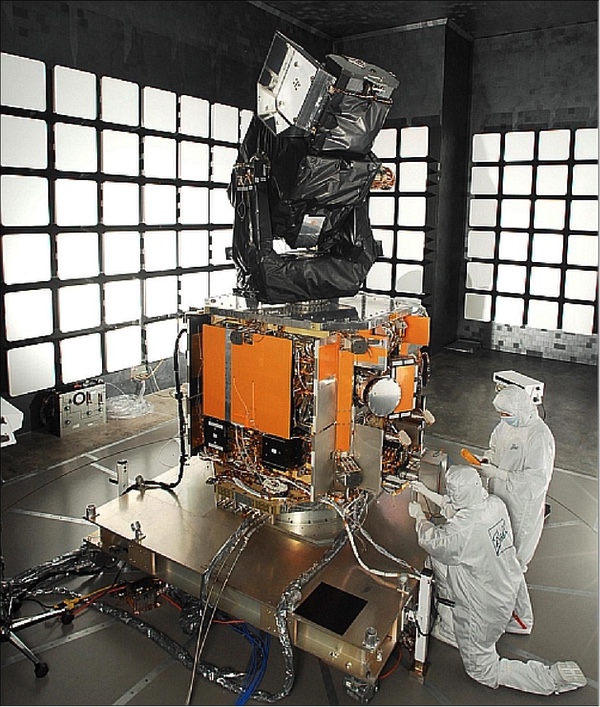 The SBSS 1 satellite. Source |
Like SBSS 1, the 14F150 satellites may be used to make long-distance observations of objects in a wide variety of orbits and have goals similar to those announced for SBSS. Still, there appear to be two key differences. One is that, in addition to space surveillance, they are employed for Earth remote sensing. The other is that they have all been co-planar with reconnaissance satellites. After Kosmos-2519 used one of Russia’s own spy satellites (Kosmos-2486) as a test target, the three subsequent 14F150 satellites all focused on American reconnaissance satellites. Even though they have not approached them any closer than several dozen kilometers, pictures obtained by the 14F150 satellites should be detailed enough to discern at least some key features of the target satellites.
What exactly Russia aims to learn from these observations is open to speculation. One obvious goal would be to gain insight into the operational capabilities of these satellites. Another possible objective is to obtain information that facilitates the use of ASAT systems against them. Russia has two types of ground-based laser systems, one mobile (Peresvet) and another stationary (Kalina), to temporarily dazzle foreign reconnaissance satellites when they fly over Russian territory.[9] At least a basic understanding of the nature and placement of on-board optical systems should be required for them to be rendered inoperable by the laser beams. Any knowledge about the design of the satellites would also come in handy to disable them with other ASAT systems such as projectiles, explosives, or chemical sprayers, all of which may be under development as part of Nivelir and Burevestnik. The fact that foreign reconnaissance satellites are a key target of these projects is, in fact, implicitly confirmed on the website of TsNIIKhM, which says it is engaged in creating “high-tech space systems for monitoring the effectiveness of defensive measures against foreign technical reconnaissance [assets].”[10]
Satellite platforms
The 14F150 parent satellites
In its announcement on the launch of Kosmos-2519 in 2017, the Ministry of Defense called it “a space platform on which several types of payloads can be installed.” This indicated that instead of having a unique design, the 14F150 satellites use a bus that can accommodate a variety of military and civilian payloads. The only platforms designed by NPO Lavochkin this century are Navigator, Karat, and Karat-200. Navigator is a heavy platform that cannot be launched by the Soyuz-2.1v rocket, ruling it out as a candidate for the 14F150 satellites. Karat is a much lighter platform with a mass of up to 100 kilograms and a payload of up to 140 kilograms. It was designed to host small scientific payloads and flew two missions in 2012 and 2014 (Zond-PP and Relek), which had to be cut short because of technical problems. By the middle of last decade, the Russian Academy of Sciences decided to abandon it for any future missions.
Some of those payloads were switched to a more capable platform called Karat-200 that NPO Lavochkin began promoting early last decade, albeit with little fanfare: it is still nowhere to be found on the company’s current website. While the payload mass remained unchanged, the mass of the platform was increased to 200 kilograms, hence the name Karat-200. However, both the platform and payload mass grew significantly in the following years.
It was also clear from several publications that one of the missions being eyed for Karat-200 was space situational awareness. In one presentation in 2012, six satellites based on the Karat-200 bus were shown. The upper three were for “fundamental space research” and the lower three for “studies of the Earth and near-Earth space.”
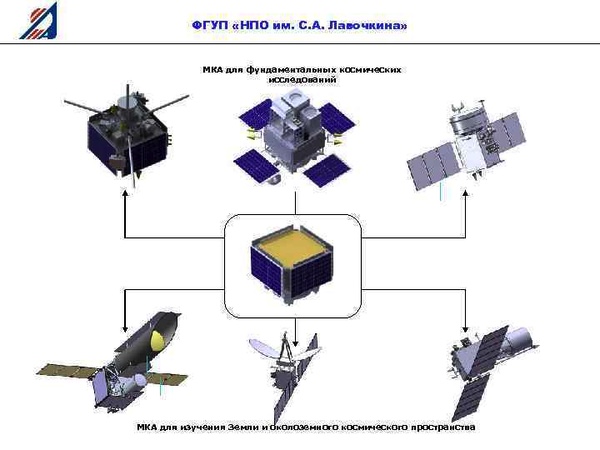 Slide from an NPO Lavochkin presentation. Source |
The satellite in the lower left was shown again during a presentation by NPO Lavochkin at a military exhibition in Moscow in 2016. This was during a roundtable discussion on the use of small satellites for military purposes. The presentation was given by Nikolai Klimenko, who had joined NPO Lavochkin in 2012 after a long career in Russia’s Military Space Forces. A slide showing the satellite can be seen in a picture taken during Klimenko’s presentation, but the resolution is not high enough to make out any details.
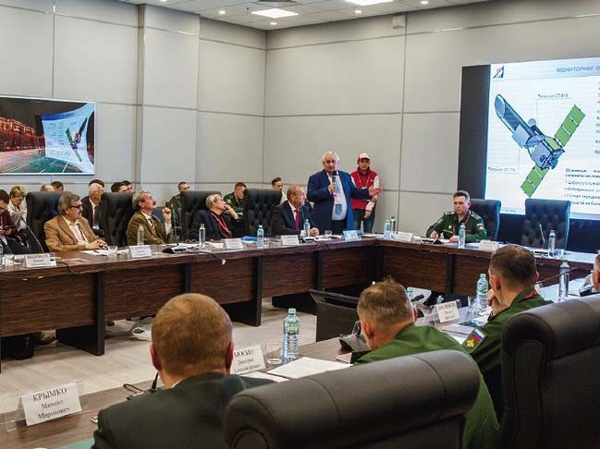 A Karat-200 based satellite for Earth and satellite observations. Source |
The year before, Klimenko had already written an article on space surveillance satellites in which he singled out Karat-200 as a possible platform for optical payloads to observe objects in geostationary orbit.[11] In addition to that, Karat-200 was proposed as a platform for observations of satellites in a 2016 article by specialists of MAK Vympel (although it was confusingly identified there simply as Karat.)[12] This is another sign that the company may well play a supervising role in Nivelir.
Indirect confirmation that the 14F150 satellites employ the Karat-200 platform came in an article in 2022, which said the platform had already been flown.[13] No civilian satellites based on Karat-200 have been launched so far, leaving 14F150 as the only candidate. The first civilian iterations of the platform will probably be a pair of high-resolution remote sensing satellites called Pixel-VR, which will become part of a new constellation of such satellites called Avtograf. When the project was officially announced in the summer of last year, its chief designer said the two satellites will be based on “the tried-and-tested Karat-200 platform,” yet more proof that flight experience has been gained with it.[14] The announced mass of the satellites is 590 kilograms, suggesting that the mass of the bus may have more than doubled over the past decade.
The two Pixel-VR satellites appear to be under construction and may well use spare hardware from the Nivelir project. The telescope that will be mounted on the platform (equipped with silicon carbide mirrors) does seem to have a totally new design that has nothing in common with the 14F150 payload. The project coordinator is a company called Russian Space Systems, with NPO Lavochkin acting as a subcontractor. Follow-on satellites of the Avtograf constellation are expected to use a new, much smaller platform that is easier and cheaper to produce serially.
 The Pixel-VR satellite based on the “tried-and-tested” Karat-200 platform. Source |
The best evidence yet that the 14F150 satellites use the Karat-200 platform is provided by an in-flight picture of Kosmos-2558, the third satellite in the series (see the image at the top of this article.) It appeared in the 2024 edition of the Center for Strategic and International Studies’ annual “Space Threat Assessment” reports.[15] The picture was credited to HEO Robotics, a company that flies cameras as hosted payloads on commercial microsatellites to obtain images of other objects in orbit. Since the Earth is in the background, Kosmos-2558 must have been imaged from a satellite orbiting above it. This is also more or less the way it should look from the vantage point of USA 326, the US spy satellite that is most likely a target of observation for Kosmos-2558 and is flying roughly 40 kilometers higher than the Russian satellite. The satellite seen in the image bears at least some resemblance to the Karat-200 platform. Like Karat-200, it has two solar panels consisting of two segments each. The white feature in the center is the platform and mounted on it is some type of upward pointing payload not unlike the telescopes seen in some of the NPO Lavochkin slides.
| There is evidence that TsNIIKhM has studied the possibility of making the Nivelir subsatellites hard to detect by ground-based radars. |
Some information is available on the propulsion and attitude control systems of the 14F150 satellites. The propulsion system features K50-10.5 monopropellant hydrazine thrusters built by OKB Fakel. These are also flown on several other Russian satellites. They have a thrust between 0.113 and 0.548 newtons and a specific impulse between 176 and 216 seconds. One drawing shows their placement on the Karat-200 platform for a scientific satellite called Rezonans. There are units consisting of one thruster (called DB-1) and units consisting of three thrusters (called DB-3). A similar configuration may be seen on the 14F150 satellites.
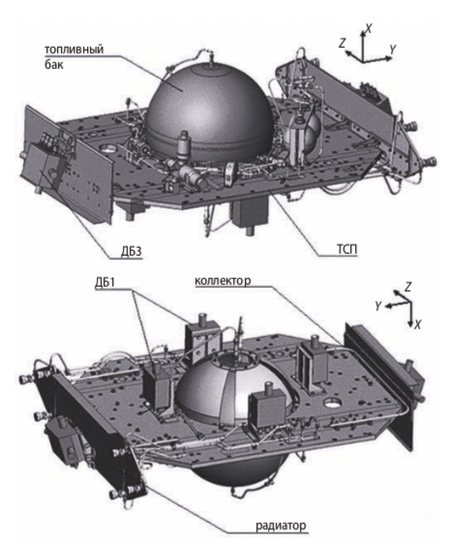 Placement of thrusters on the Karat-200 platform. Source |
Attitude control is at least partially provided by a control moment gyroscope called SGK-5, a product of the Research Institute of Command Instruments (NII KP). It weighs 4.5 kilograms and has an angular momentum of 5 newton-meter-seconds. Since the payload does not appear to be mounted on a gimbal platform, like the one on the American SBSS satellite, the entire satellite has to be positioned to point it towards orbiting targets. The control moment gyroscope makes it possible to significantly reduce propellant consumption for attitude control.
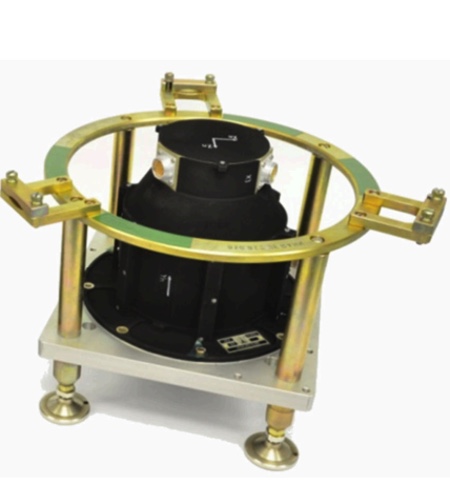 The SGK-5 control moment gyroscope. Source |
The TsNIIKhM subsatellites
Far less is known about the subsatellites developed by TsNIIKhM, presumably designated 14F162. There are strong indications that they share many design features with the Burevestnik interceptor satellites. Both seem to use monopropellant hydrazine thrusters of OKB Fakel. Designated K50-10.6, they draw their propellant from a tank manufactured by NIIMash known as MVSK 84. This has a capacity of roughly eight liters.
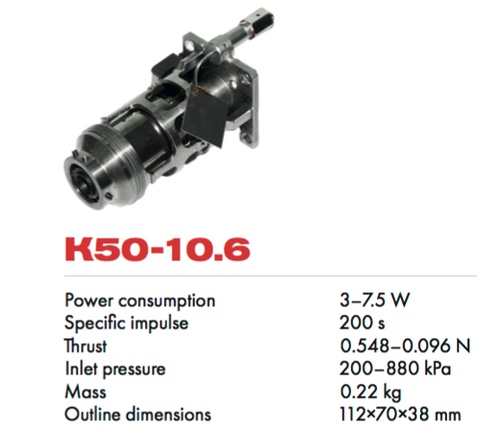 Data sheet on the K50-10.6 thruster. Source: OKB Fakel |
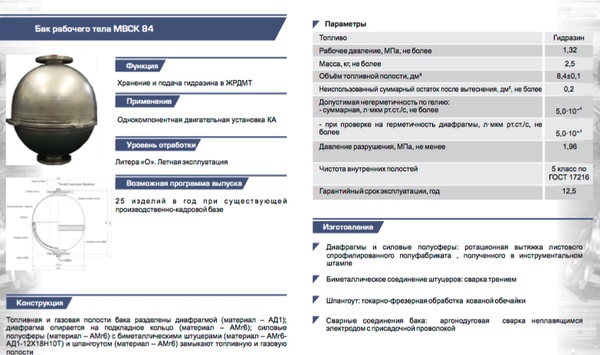 Data sheet on the MVSK 84 hydrazine tank. Source: NIIMash |
Several patents and papers published by TsNIIKhM over the years are most likely related to the propulsion system of both the Nivelir subsatellites and the Burevestnik interceptors. They describe a fuel-efficient way of performing orbital maneuvers and ensuring attitude control using a combination of thrusters and reaction wheels. One paper published in September 2015 noted that the use of the thrusters in this specific mode had already been successfully tested in flight. This must have been a reference to the inspection satellites launched by the Rokot launch vehicle in 2013–2015. Schematic representations of satellites seen in those publications may very well show the configuration of thrusters and reaction wheels on the satellites. One of them gives a satellite mass of 54 kilograms.[16] Assisting in rendezvous and proximity operations are laser rangefinders and computer vision systems developed jointly with the State Ryazan Instrument Factory (GRPZ).
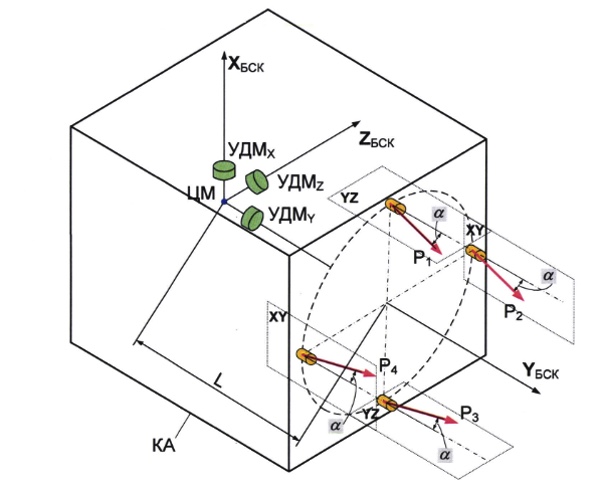 One possible configuration of thrusters and reaction wheels on a TsNIIKhM microsatellite. Source |
One other system that the Nivelir subsatellites and the Burevestnik interceptors have in common is a set of lithium-ion batteries called 4LI-20. Developed by PAO Saturn, these have a design lifetime of five years. They were first flown on Kosmos-2491, the first of the Rokot-launched inspector satellites. Yet another system that may be shared by both satellites is an on-board computer called VM24, the development of which can be traced to the Moscow Institute of Physics and Technology, a university with which TsNIIKhM has close ties. The on-board radio system was provided by OKB MEI and, based on monitoring by Western radio amateurs, includes a transmitter operating at a frequency of 2,280 megahertz.
There is evidence that TsNIIKhM has studied the possibility of making the Nivelir subsatellites hard to detect by ground-based radars. In November 2016, it signed a contract under the Nivelir project with a company based in St. Petersburg called NII Ferrit-Domen. Documentation related to this contract only mentions tests of a “protective coating” without specifying what purpose it would serve. However, NII Ferrit-Domen is known to produce radar-absorbing materials using thin films of hydrogenated carbon with ferromagnetic nanoparticles. According to a former version of the company’s website, the material is intended “to lower the radio visibility of ground-based, sea-based, airborne and space-based technology” and is also capable of absorbing radiation in the optical and infrared regions of the spectrum. The work done by Ferrit-Domen for TsNIIKhM is referred to as Nivelir-RP, where “RP” almost certainly stands for “radar absorbing coating” in Russian. Additional evidence that the work is related to stealthy material comes from the annual reports of NII Ferrit-Domen for 2012 and 2013, which mention joint work on radar absorbing materials with TsNIIKhM under a research project called Nota-D.
Virtually nothing is known about the objects ejected at high speed from two of the subsatellites and interpreted by the Pentagon as ASAT projectiles. Since they were deployed from the subsatellites, they must be very small in size themselves. Neither of them displayed any more activity after being fired from the subsatellites and visual observations suggest they tumbled uncontrollably afterwards. All this may point to the use of some type of miniature solid-fuel propulsion system. Arrays of solid-fuel microthrusters can be developed with the help of micro-electromechanical system (MEMS) technology and have been used as propulsion systems on some cubesats. They usually have a sandwich-type structure, consisting of an ignition layer, a combustion chamber layer and a nozzle layer.
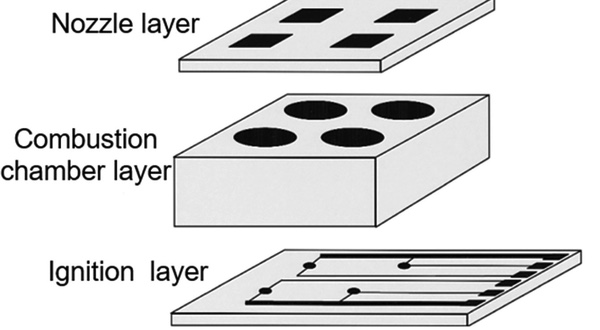 Configuration of a solid-fuel microthruster. Source |
TsNIIKhM’s Nanotechnology Research Center worked on such thrusters under research projects called Nota-Kh (2012–2015) and Naveska-Kh (2016–2017). This was in collaboration with the Mendeleyev University of Chemical Technology (RKhTU), more specifically its Department for the Chemistry and Technology of Organic Nitrogen Compounds (KhTOSA). In 2016, researchers of TsNIIKhM’s Nanotechnology Research Center and RKhTU jointly published a patent called “solid-fuel charge for micro engines.” In the authors’ words, the engines were planned to be used to “create a torque or correct the flight trajectory of a special small-size object.”[17] In 2017, the RKhTU researchers wrote a report on “the development and testing of fuel elements for engines of small satellites”. No solid-fuel microthrusters have so far been flown on any Russian civilian satellites, raising the possibility that this work was indeed related to the Nivelir projectiles. [18]
References
- Not all sources of information will be referenced in this article. Most links can be found in various related threads on the NASA Spaceflight Forum: Nivelir program thread, mission threads for Kosmos-2519/2521/2523, Kosmos-2535/2536/2537/2538, Kosmos-2542/2543, Kosmos-2558, Kosmos-2576. Note that many of the links are no longer active or now blocked outside Russia.
- The 14F162 designator is only seen in this source.
- See for instance: J. Sciutto, CNN gets an inside look at Space Force, CNN, August 6, 2021.
- B. Hendrickx, Burevestnik: an air-launched anti-satellite system, The Space Review, April 27, 2020 ; Burevestnik thread on the NASA Spaceflight Forum.
- B. Hendrickx, Russia’s secret satellite builder, The Space Review, May 6, 2019 ; TsNIIKhM thread on the NASA Spaceflight Forum.
- Biography of Vladimir Verkhoturov, p. 3.
- MAK Vympel annual reports can be downloaded here.
- Publication on the occasion of NII Televideniya’s 80th anniversary, p. 3.
- B. Hendrickx, Peresvet: a Russian mobile laser system to dazzle enemy satellites, The Space Review, June 15, 2020 ; B. Hendrickx: Kalina: a Russian ground-based laser to dazzle imaging satellites, The Space Review, July 5, 2022.
- Page on the TsNIIKhM website dedicated to its space-related activities.
- Article in NPO Lavochkin’s journal, 2015, pp. 16-22.
- Article published in 2016.
- Article published in 2022, p. 51.
- TASS report, July 2, 2024.
- Space Threat Assessment 2024, p. 18.
- Article published in 2019.
- Patent published in 2016.
- Solid-fuel microthrusters may have been tested by an unannounced military cubesat-sized payload that was on board the first Angara-A5 to fly from the Vostochnyi cosmodrome in April 2024. Designated 2024-069D, it raised its apogee by about 100 kilometers after having separated from the rocket’s Orion upper stage.
Note: we are now moderating comments. There will be a delay in posting comments and no guarantee that all submitted comments will be posted.
